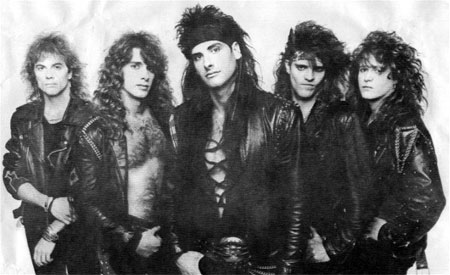
SUMMARY
- Album Art: 2/5
- Musicianship: 9/10
- Vocal Quality: 9/10
- Vocal Uniqueness: 9/10
- Song Consistency: 9/10
- Song Writing Quality: 8.5/10
- Lyrics: 8.5/10
- Heaviness/Grit: 9/10
- Production Quality: 8.5/10
- OVERALL SCORE: 8.6/10
Lineup: Rob Newhouse (vocals), Rob Kruger (guitars), Roger Moore (guitars), Tracy Shell (Drums), John Lockner (Bass)
HISTORY

Based out of Minnesota, the hair metal act GEMINI first garnered attention in the late 80s, and soon became one of the largest bands in the Midwest. Their self-titled debut album in 1990 even got the band some national attention, including offers from some of the major labels. GEMINI turned down multiple contract offers from studios including Warner Bros in the hopes of getting more favorable contract terms.
Then, as the grunge wave took over and metal fell out of the national spotlight, GEMINI too fell into obscurity. Vocalist Lance King left the group in the mid-90s after their second album Out For Blood failed to re-capture the attention of their first record. GEMINI returned with a new lineup and a heavier, more modern sound with 1997’s The Spiritual Dimensions of Music. The album was a limited, independent release and never got circulated outside of the region. It also turned out to be the last release by the band. This is a shame because it could have been considered one of the best metal efforts of the late 1990s. The Spiritual Dimensions of Music is on par other late 90s metal albums like FIGHT’s A Small Deadly Space or OVERKILL’s The Killing Kind and deserves more recognition than it initially received. Therefore, we are revisiting the album in 2020 to bring it to a new audience.
REVIEW
The first six tracks on The Spiritual Dimensions of Music are a mix of groove metal, technical prowess and top-tier metal vocals. The production is sludgy but each instrument is mixed in well and has an opportunity to stand out. The guitar performances by Roger Moore and Rob Kruger are superb throughout the album, and some of the guitar solos are reminiscent of Dimebag Darrell.
The album opener “Tyrant” is pure groove metal. Rob Newhouse on vocals is angry but hits every note with finesse and ease. His vocals are a nice mix of grit and melody (similar to Cowboys from Hell-era Phil Anselmo). The track isn’t groundbreaking but it does everything well. Each member of the band is on point. The guitars show precision and Newhouse stands out as a singer that had the chops to compete with the metal legends.
“Heaven” gives John Lockner a chance to standout on bass as he leads the way early in the track with the guitars coming in and out of focus. The song is lighter than the opener but a standout nonetheless. It also became a regular on the band’s live setlist.
The third track, “Junkie” is the most aggressive and experimental song on the entire album. It throws melody out the window and leans more towards an industrial metal sound. The track uses a lot of vocal distortion and the chorus reminds me of something out of the STATIC-X catalogue. The band continues to operate at a high-level though, regardless of the song structure.
Next up is “Ashes”, which could have been a metal radio track and does not have any weak points. Newhouse’s vocals soar, the guitar solos are technical perfection, and the listener will want to nod their head from start to finish.
Up fifth is “Old Man Johnson”. This song is the definition of groove metal. It is slow, sludgy, and heavy. Newhouse shows off his vocal range replacing the low register from earlier tracks with an ability to hit the high notes. His high-pitched screams could contend with Rob Halford at his peak. It’s easily one of my personal favorites on the album.
“Tears of Allah” is the most dynamic and, overall, most impressive track on the entire album. It includes elements of groove metal, thrash metal, and power metal. There is a middle-eastern vibe to the guitar riffs which go well with the lyric content. Newhouse’s vocals are more reserved here; he replaces the full-on aggression approach, instead flowing effortlessly from subdued to soaring power-metal singing. Rob Kruger and Roger Moore trade guitar solo’s that blend seamlessly into the track. In fact, each section of the songs weaves into the next, a testament to the strong songwriting on “Tears of Allah”.
Now, we come to the downside of the album. “Sativa” is mostly an interlude, not a full-fledged song. The album closer “Cheatin’ Kind”, a bluesy parody track, is a departure from the rest of the album. It’s certainly entertaining and good or what it is but doesn’t really fit with the rest of the album. In all, at 8 official tracks (and only 6 ‘true’ songs), the album is just too short.
CONCLUSION
Overall, you can take any of the first six tracks from this album and make an argument that they belong among the best metal songs of the 1990s. While the album loses some points due to its short run time, it makes up for this with a lack of filler. The Spiritual Dimensions of Music did not receive the attention it deserved back in 1997 but those of us at Heavy Metal Culture would like to highlight it again in 2020 to give metal fans a second chance to hear a great metal album that, frankly, very few of us has heard.
HIGHLIGHTS
“Ashes”, “Old Man Johnson”, “Tears of Allah”

Leave a Reply